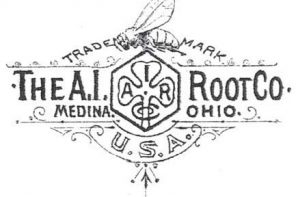By: Jay Evans
 Varroa mites remain enemy number one among the living threats to honey bees. This is despite decades of attempts to understand and control these mites in Europe, then the Americas, and now across most of the beekeeping world. A prominent bee research professor told me in the early 2000s that the Varroa mite issue was under control, new chemical treatments were doing the trick and the mite would soon be vanquished. This was comforting to me at the time, since I had been hired to research American foulbrood disease. I was beginning to suspect that AFB was a 1950s sort of issue for beekeepers, who had just received word that small hive beetles were spreading and who seemed quite focused on mite impacts. Almost 20 years later, that professor has long retired and Varroa mites did not follow his suggestion.
Varroa mites remain enemy number one among the living threats to honey bees. This is despite decades of attempts to understand and control these mites in Europe, then the Americas, and now across most of the beekeeping world. A prominent bee research professor told me in the early 2000s that the Varroa mite issue was under control, new chemical treatments were doing the trick and the mite would soon be vanquished. This was comforting to me at the time, since I had been hired to research American foulbrood disease. I was beginning to suspect that AFB was a 1950s sort of issue for beekeepers, who had just received word that small hive beetles were spreading and who seemed quite focused on mite impacts. Almost 20 years later, that professor has long retired and Varroa mites did not follow his suggestion.
A key strategy for reducing Varroa impacts is to interfere with female mating and reproduction. Coupled with hygienic behavior and controls aimed at vulnerable, exposed, female mites, reducing female reproductive success can greatly reduce the threats of Varroa mites at the colony level. This is due to the fact that Varroa females really aren’t that productive, rearing at best a few female offspring in each reproductive round and generally, at least in worker cells, producing just a couple new mites. If reproduction can be reduced by even a fraction, this will help cap mite levels late in the season, when mites become filthy circulators of bee viruses.
Benjamin Conlon and colleagues have made a major breakthrough in the identification of potential features of bee physiology that put a lid on mite reproduction. In their study (“A gene for resistance to the Varroa mite (Acari) in honey bee (Apis mellifera) pupae”, Molecular Ecology, in press, DOI: 10.1111/mec.15080), the authors used a mapping strategy to identify a high-value target for bee breeding.
As with most scientific breakthroughs, the study required luck, insight, and collaboration across several research groups. The luck came in the form of a honey bee population in Toulouse, France, that showed an extremely high frequency of failed mite reproduction. The insight came in only screening male honey bees from that population. Besides just targeting the sex that is most attractive and supportive of Varroa, the focus on males allowed these researchers to use a fascinating trait of honey bee biology to speed the search for genetic resistance.
Male honey bees are haploid from birth to death. Unlike female queens and workers (and ourselves for that matter) male honey bees have no father and every cell in their bodies holds chromosomes that are a genetically identical copy of the egg that gave rise to that individual. This is golden for genetic trait analysis, since traits cannot be masked by variants on an alternate chromosome and as such are fully exposed to view. It is also golden for breeding since, once identified in a single male, a trait can be bred in an invariant way into every queen and worker who that male fathers (through the wonder of instrumental insemination). Double golden and a rarely exploited tool for bee breeding.
More luck came in finding a single colony in which half of the males were conducive to mite reproduction while half stymied female mites. For the latter half, all female mites emerged, if they emerged at all, with no offspring. If you remember Mendel and his peas, or some other lesson from a distant genetics class, this perfect 50/50 ratio suggests that the trait of interest, here a ‘something’ that keeps mites from starting a family, is most likely driven by a single gene. Triple golden, since forcing a single gene variant into a population and keeping it there by breeding is way easier than juggling dozens of genes each of which plays a minor role, the bugbear of breeding schemes in bees, plants, and livestock.
One last fact of bee biology worked to the advantage of these authors. Across most of the tree of life, when a female generates the haploid (single set of chromosomes) eggs that will be fertilized with a male-sourced similarly haploid cell (sperm, pollen, etc.) to make a diploid (two-copy) offspring, there is a substantial amount of sloppiness between the two pairs of chromosomes that give rise to these haploid sex starters. This leads to crossing over (recombination) and a general reshuffling of the paired decks of genes held by both mom and dad. Reshuffled decks help expose new combinations of traits to selection, a phenomenon thought to be the key driving force for sex in the first place (don’t worry I will mention hormones too, below). If you find this primer on egg production confusing, or boring, just remember one thing, honey bee eggs reshuffle their decks at a rate tenfold higher than almost all other forms of life (a jaw dropping rate of 20 centiMorgans per million base-pairs for those who really liked the preceding paragraph).
The impacts of this high recombination rate on honey bee health, let alone the reason it exists in the first place, are hot topics of debate. What is not debatable is that this high recombination rate is a lifesaver for scientists trying to map the key genetic features of bee biology. By chopping bee chromosomes into an aggregate of really short linked chunks from mom and dad, this means that various chunk-identifying techniques (worthy of Nobel Prizes in 1933 and 1978) can map traits to extremely small regions, even single genes. By scoring a mere 45 (haploid) drone bees that is exactly what the authors did, finding that resistance was most likely caused by mutations in a single gene that makes a protein called MBlk-1 (Mushroom body large-type Kenyon cell-specific protein-1, for you details freaks). It would be hard to predict a protein that is a better candidate for messing with mite reproduction than Mblk-1. This protein, despite the pretentious name, is actually produced in many bee cells, including the fat body which was recently shown to be the major food source of Varroa mites (Ramsey et al., 2019,doi:10.1073/pnas.1818371116). More importantly, Mblk-1 is a huge enabler, that takes a change in hormone levels (i.e., the molting hormone needed to finish off a bee’s transition from larva to adult) and sets in motion numerous events that help turn a pale grub into the bees we see emerging from capped cells. These changes, of course, are all happening exactly when Varroa mites are doing their reproductive business.
The authors suggest that the changes driven by a mutated MBLK-1 somehow throw off mite females. Perhaps mites don’t get a particular smell needed to warm their ovaries? Perhaps they do not receive a vital nutritional component, or something produced by the mutated bees they are feeding on is toxic to them? Or maybe honey bee workers notice and hygienically remove bees with mutants for this protein? However the mechanisms shake out, this trait, which arose naturally in honey bees under intense mite pressure in France, is a very attractive target for breeding. Still, in order to make this more than a good-news story for one beekeeper in Toulouse, much more needs to be resolved. Are these mutations bad for bees? Do they work for female (worker)-destined pupae? Can mites evade this suppression as they have done for human-made attacks?
I am almost naive enough to declare victory on mites, but will not do so until more of these fundamental questions are answered. It will also help to see how this protein behaves in Asian bees and against Asian Varroa mites. MBlk-1 levels are turned up in parasitized (drone) bees in Apis cerana (T. Ji and colleagues, 2014, “Transcriptional responses in eastern honeybees (Apis cerana) infected with mites, Varroa destructor. Genetics and Molecular Research, 13(4), 8888-8900, https://www.geneticsmr.com/articles/3664”), suggesting some sort of role there, or at least a response to mite attacks.
While this is not the first study to use the power of honey bee males to identify traits, nor is it the first to exploit the honey bee genome (see the latest on that in a paper by Andreas Wallberg and colleagues, “A hybrid de novo genome assembly of the honey bee, Apis mellifera, with chromosome-length scaffolds. BMC Genomics, 20(1), 275. doi:10.1186/s12864-019-5642-0”), it is exciting because it marries the two so well and it does so by tackling a terrifying threat to honey bees. No promises, but (wink, wink) keep an eye on this trait as more researchers in the next year determine how much of mite resistance it can explain.






